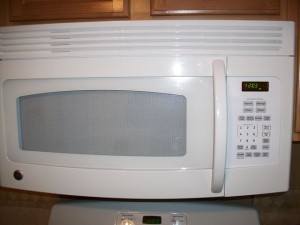Being exposed to high levels of microwave radiation can cause health problems, such as cataracts and burns. While most microwave oven leaks are considered to be too small to create such significant health risks, a microwave that is leaking radiation could cause unknown health risks and isn’t likely to be as efficient as it should be. In this tutorial you will learn how to check your microwave for radiation leakage, and no special tools or experience are required.
Steps
Wireless Netbook method
This method works best because microwaves and wireless networks operate on very nearly the same electromagnetic frequency (between 2.4 and 2.5 GHz).
1. Unplug your microwave from the power socket. For wall switches, remove the whole electric plug from the wall socket (power point) rather than simply turning off the switch.
2. Check that your netbook has a working 802.11 wireless card and is on your local network.
3. Place the netbook in the microwave. Do not turn the microwave on!
4. Close the microwave door.
5. Ping your netbook. If the ping is answered, the microwave leaks radiation. If the packets time out, everything is fine.
Cell Phone Method
1. Put your cell phone in the microwave. Shut the door.
2. Do not turn on the microwave!
3. Dial the number of your cell phone. If it rings, you have a leak. If it doesn’t ring, your microwave oven is fine.
Fluorescent light method
1. Find a fluorescent tube.
2. Darken the room
3. Hold it against the edges of the microwave oven’s door when the oven is in use. While normally it is not recommended to use the microwave with nothing inside it, in this short experiment, it is best not to add anything to the oven. If your microwave oven is pre-1980s, however, add a glass of water.
4. Check for a reaction. If there is microwave leakage occurring, the bulb will glow.
What To Do Next
If you find a leak, or you still believe that there might be a leak even if these tests have not proven anything to your satisfaction, here are some suggestions for what to do next.
1. Check the hinges, latch, center door panel, and seal of the door. If microwave radiation is leaking, it is usually as a result of worn or broken elements on the microwave oven’s door. Any of the following signs could indicate leakage:
- Look for cracks on the hinges or seals
- Look for worn seals
- Look for dents or breaks in the door itself.
2. Take the microwave to a professional repair shop for testing and fixing. Note that the FDA in the USA does not certify any home leakage protectors, which can sell anywhere from around US$10-50. In fact, the FDA states that it has tested a number of these and found them inaccurate and unreliable, and says that they should be used only for an approximation of leakage. The reality is that proper testing requires expensive equipment using a radio-frequency radiation probe, which is not only expensive but also requires technical training to operate. Such sophisticated testing devices used by public health authorities to measure oven leakage are far more accurate, as well as being periodically tested and calibrated. Hence, the FDA recommends the following:






Hands down, Apple’s app store wins by a mile. It’s a huge selection of all sorts of apps vs a rather sad selection of a handful for Zune. Microsoft has plans, especially in the realm of games, but I’m not sure I’d want to bet on the future if this aspect is important to you. The iPod is a much better choice in that case.
Hello!, Very interest angle, we were talking about the same thing at work and found your site very stimulating. So felt compelled to com?ment a little thank you for all your effort. Please keep up the great work your doing!
Can I just say what a relief to search out someone who really knows what theyre talking about on the internet. You definitely know methods to convey an issue to mild and make it important. More people must learn this and perceive this aspect of the story. I cant consider youre no more fashionable because you definitely have the gift.